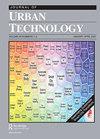来自编辑
IF 4.6
3区 经济学
Q1 URBAN STUDIES
引用次数: 0
摘要
在这期开放的《城市技术杂志》中,我们有各种各样的文章,涉及熟悉的(技术转让,在线社区网络)和不熟悉的(使用区块链技术保护街头艺术家的知识产权)问题。在第一篇文章“市场介导的技术转移和地域扩散的不确定性:来自中国技术流动的证据”中,Dongho Han和Ilwon Seo试图利用中国的专利许可记录来解决市场介导的地域内和跨地域的技术转移。他们使用的数据集使他们能够捕捉到地理在许可关系中的重要性——这是一个重要的新见解。他们的讨论引导他们梳理出创新系统(如三螺旋模型中概述的那些)对公共行为者的影响;调查买家/供应商偏好不同空间尺度的政策影响;并展示了地理上的接近是如何被揭示为一种风险规避手段的。这组作者看到了在中国背景下使用专利许可数据来跟踪区域间技术流动的三个优势。首先,专利许可数据“表明具有经济价值的技术流向创新成果。”其次,许可数据集描绘了“区域到区域的技术流动”。第三,许可合同“反映了组织的战略决策”。通过对这些数据的分析,作者得出这样的结论:“尽管存在市场机制,地理邻近性在知识扩散中仍然发挥着重要作用,类似于纯粹的知识溢出。”然而,他们指出,在他们研究的中国地区,韩和徐发现,“地理集聚是触发经济增长的必要条件,但不是充分条件”。噪音污染和如何改善噪音污染是城市规划中的重要问题,尽管没有得到足够的研究。Rosa Aguilar、Johannes Flacke、Daniel Simon和Karin Pfeffer在他们的文章“OGITO介导的噪声行动规划中的利益相关者参与:一个开放的地理空间互动工具”中描述了一种数字工具的发展,该工具促进了噪声行动规划背景下利益相关者的参与和公众话语。本文的重点是如何在协同空间规划中使用地图。研究人员通过合作开发了一种工具,使利益相关者能够确定暴露于较高噪音水平的特定地点和人群,目标是规划减排策略。由于大流行,利益攸关方有时远程参加这些会议,有时亲自参加。远程会议的成功将在未来用于让只能远程参与的受影响社区的成员参与进来。这项由Jonas De Meulenaere、c本文章由计算机程序翻译,如有差异,请以英文原文为准。
From the Editor
In this open issue of the Journal of Urban Technology, we have a diverse collection of articles dealing with both familiar (technology transfer, online neighborhood networks) and unfamiliar (using blockchain technology to protect the Intellectual Property rights of street artists) issues. In the first of these articles, “Uncertainty in Market-Mediated Technology Transfer and Geographical Diffusion: Evidence from Chinese Technology Flow,” Dongho Han and Ilwon Seo attempt to tackle market-mediated technology transfer within and across geographies drawing upon patent licensing records in China. The data set they use allows them to capture the importance of geography in licensing relationships—an important new insight. Their discussion leads them into teasing out the implications for public actors within innovations systems (such as those outlined in the Triple Helix model); investigating the policy implications of purchasers/providers preferring differing spatial scales; and displaying how geographic proximity is revealed as a means of risk aversion. The authors see three advantages of using patent licensing data in a Chinese context to track region-to-region technology flows. First, patent licensing data “indicate the flow of technology with economic value geared toward innovative outcomes.” Second, the licensing data set portrays “region-to-region technology flows.” And third, a licensing contract “reflects an organization’s strategic decisions.” The analysis of these data allowed the authors to conclude that “despite the presence of market mechanisms, geographical proximity still plays an important role in the diffusion of knowledge, similar to that of pure knowledge spillover.” However, they noted that in the regions of China that they studied, Han and Seo found that “geographical agglomeration is an essential, but not a sufficient condition” to trigger economic growth. While not studied as much as seems warranted, noise pollution and how to ameliorate it are important issues in city planning. In their article, “Stakeholders Engagement in Noise Action Planning Mediated by OGITO: An Open Geo-Spatial Interactive TOol,” Rosa Aguilar, Johannes Flacke, Daniel Simon, and Karin Pfeffer describe the development of a digital tool that facilitates stakeholder engagement and public discourse in the context of noise action planning. The focus of the article is on how maptables can be used in collaborative spatial planning. The researchers used collaboration to develop a tool that was able to allow stakeholders to identify specific locations and populations that were exposed to higher levels of noise with the goal of planning abatement strategies. Because of the pandemic, the stakeholders participated sometimes remotely in these sessions and sometimes in person. The success of the remote sessions will be used in the future to involve members of the affected communities who can only participate remotely. The goal of the study written by Jonas De Meulenaere, Cédric Courtois, Michel Walrave, Lieven J.R. Pauwels, Wim Hardyns, and Koen Ponnet has a clearly defined goal: to determine the prevalence of the use of online neighborhood networks (ONNs) and explore which sociodemographic, socioeconomic status, social integration, and media use determinants predict ONN membership and use in the city of Ghent, Belgium. Their article, “Exploring the
求助全文
通过发布文献求助,成功后即可免费获取论文全文。
去求助
来源期刊

Journal of Urban Technology
URBAN STUDIES-
CiteScore
8.50
自引率
4.20%
发文量
42
期刊介绍:
The Journal of Urban Technology publishes articles that review and analyze developments in urban technologies as well as articles that study the history and the political, economic, environmental, social, esthetic, and ethical effects of those technologies. The goal of the journal is, through education and discussion, to maximize the positive and minimize the adverse effects of technology on cities. The journal"s mission is to open a conversation between specialists and non-specialists (or among practitioners of different specialities) and is designed for both scholars and a general audience whose businesses, occupations, professions, or studies require that they become aware of the effects of new technologies on urban environments.
 求助内容:
求助内容: 应助结果提醒方式:
应助结果提醒方式:


